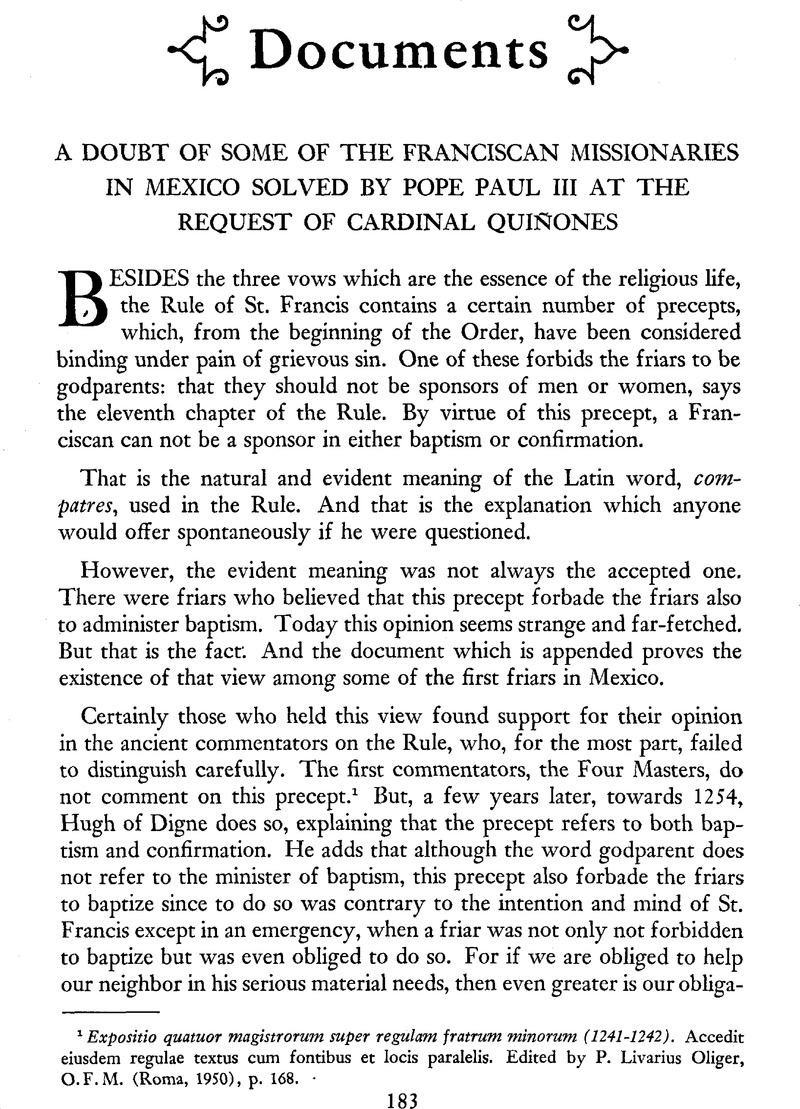Article contents
A Doubt of Some of the Franciscan Missionaries in Mexico Solved by Pope Paul III at the Request of Cardinal Quiñones
Published online by Cambridge University Press: 11 December 2015
Abstract

- Type
- Documents
- Information
- Copyright
- Copyright © Academy of American Franciscan History 1957
References
1 Expositio quatuor magistrorum super regulam fratrum minorum. (1241–1242). Accedit eiusdem regulae textus cum fontibus et locis paralelis. Edited by Oliger, P. Livarius O.F.M. (Roma, 1950), p. 168.Google Scholar
2 Licet mos habet hos precipue qui de sacro fonte vel episcopi confirmatione recipiunt compatres appellare, non minus tamen (ut volunt) compaternitas ex baptismi collatione contrahitur, fratres impediens ne baptizent nisi necessitate cogente. Possunt quidem periclitantem puerum baptizare saltem ubi alia deest persona que possit aut velit hoc facere; tunc enim iuste nee inter fratres nee inter homines scandalum esse potest quod regula pretendit cum dicit: ne hac occassione inter fratres vel de fratribus scandalum oriatur. Charitatisque preceptum quo proximum diligentes tenemur maxime in re tarn spirituali et necessaria subvenire, nec intendit sanctus nec potuit irritare. Necessitas enim ut canon loquitur legem non habet. Que autem maior necesitas quam animam proximi damnationis eterne periculo liberare? Ubi autem non cogit necessitas, non est nostri officii baptizare. Non misit nos Christus baptizare sed evangelizare.” Digna, Hugo de in Monumenta Ordinis Minorum (Salmanticae, 1506), III Google Scholar, f. 74 r-v. Argumanes, Juan de O.F.M., Speculum Fratrum Minorum (Barcinone, 1523)Google Scholar, f. XV r; and in Enchiridion seu manuale fratrum minorum (Hispali, 1535), 43 r, quotes the substance of the opinion of Hugh of Digne.
3 S. Buenaventura, Expositio super regulam fratrum minorum, cap. XI, Mon. Ord. Min., III, 43v44r. Corpus iuris canonici, XVI, q. 1 c. 8; t. I, Coloniae Munatianae, 1779, 262a-b. P. Oliger, op. cit., pp. 191–192n, reviews the legislative tradition concerning this prohibition before the time of St. Francis up to the sixth century.
4 “Contrahitur compaternitas in sacramento baptismi et confirmationis; secunda semper potest vitari, sed prima etiam nisi adsit necessitas, ut si puer esset in mortis articulo et nullus esset qui posset eum baptizare. Tunc frater tenetur ipsum baptizare.” Critical text in Analecta Franciscana (Ad Claras Aquas, 1906), IV, 424. Mon. Ord. Min., f. 94r. Quoted by P. Argumanes, loc. cit. As can be seen the opinions of Digne and Pisa were readily available to the friars of the first half of the sixteenth century in the Monumenta and the Speculum of Juan de Argumanes, published in Spanish in Seville in 1521 and almost certainly before that time as well.
5 de Paris, Graciano O. F. M. CAP., Historia de la fundación y evolución de la orden de frailes menores en el siglo XIII (Buenos Aires, 1947)Google Scholar, passim. Holzapfel, H. O. F. M., Manuale historiae ordinis fratrum minorum (Friburgi B., 1909), pp. 45–48.Google Scholar
6 Ex tabula capituli generalis meclinensis 1499 celebrati. Declaratur quod frater sacerdos in extrema necessitate potest dare parvulo sacrum baptismatis, dummodo non adsit alius sacerdos etiam in presentia virorum secularium laicorum. Et quod in regula prohibetur ne fiant compatres etc. intelligendum est quoad elevationem de fonte baptismatis, non quoad baptizationem, quia (ut dictum est) in casu necessitatis, absente sacerdote seculari vel alterius professionis, bene possunt fratres nostri sacerdotes baptizare.” Enchiridion seu manuale, f. 102r. Concerning this chapter, see Glassberger, Nicolas O. F. M., Chronica in Analecta Franciscana (Quaracchi, 1887), II, 513, 520–521 Google Scholar. A clear explanation of this precept, based on the decree of 1499, is found in Cordoba, Antonio de O. F. M., Expositio regulae fratrum minorum,’ (Lovanii, 1550)Google Scholar, Cap. XI, q. IV, f. 326v-327r. The first edition was published in 1539.
7 Concerning this question, see the special study of Ceccherelli, Claudio O. F. M., “El bautismo y los Franciscanos en México (1524–1539),” Missionalia Hispanica, XII (1955), 209–289 Google Scholar. Motolinía, T. O.F.M., Historia de los Indios (Barcelona, 1914), pp. 109–115 Google Scholar; Mendieta, J. de O. F. M., Historia eclesiástica Indiana (ed. Chavez; México, 1945), II, 115–128.Google Scholar
8 Callaey (de Amberes), Fredegando O.F.M. Cap., “L’influence des idées franciscaines spirituelles chez les frères-mineurs capucins au XVI siècle,” Miscellanea F. Ehrle, I (Roma, 1924), 388–403 Google Scholar; id., L’Italia Francescana, II (1927), 113–130.Google Scholar
9 Waddingo, W. L. O.F.M., Annales (Quaracchi, 1933), XVI, 293.Google Scholar
10 Fernández, Juan Meseguer, “Contenido misionológico de la Obediencia e Instruccion de Fray Francisco de Los Angeles a los doce apóstoles de México,” The Americas, XI (January, 1955), 498–499.Google Scholar
11 Fernández, Juan Meseguer, “Erección frustrada de la provincia del Santo Evangelio de México, 31 de diciembre de 1532,” Archivo lbero-Americano, XI (2 ép.; 1951), 475–478.Google Scholar
12 Fernández, J. M., “Contenido misionológico de la Obediencia e Instruccion…,” The Americas, XI (January, 1955), 473–500 CrossRefGoogle Scholar; id., “Quiñones solicita facultades de nuncio y virrey para Nueva España,” AIA, XIV (2 ép.; 1954), 311–338.
13 This document is reproduced in Salazar, B. O. F. M., Los doce primeros apóstoles franciscanos en México (México, 1943), pp. 162–164 Google Scholar. Other instances of Cardinal Quiñones’ intervention in behalf of the Franciscans in Mexico may be seen in AIA, XXXIV (1931), 268–273, and XI (2 ép., 1951), 477.
14 These notes are transcribed at the end of the document.
15 The particle ut is superfluous. After the words baptizandi facultatem the word concessit, which is found at the end of the period before In quorum fidem, must be inserted.
16 Two words are illegible, but they are not needed to complete the sense of the passage.
17 Quiñones in order to indicate his titular church (the Church of the Holy Cross) used the sign of the cross and not the word.
- 1
- Cited by


